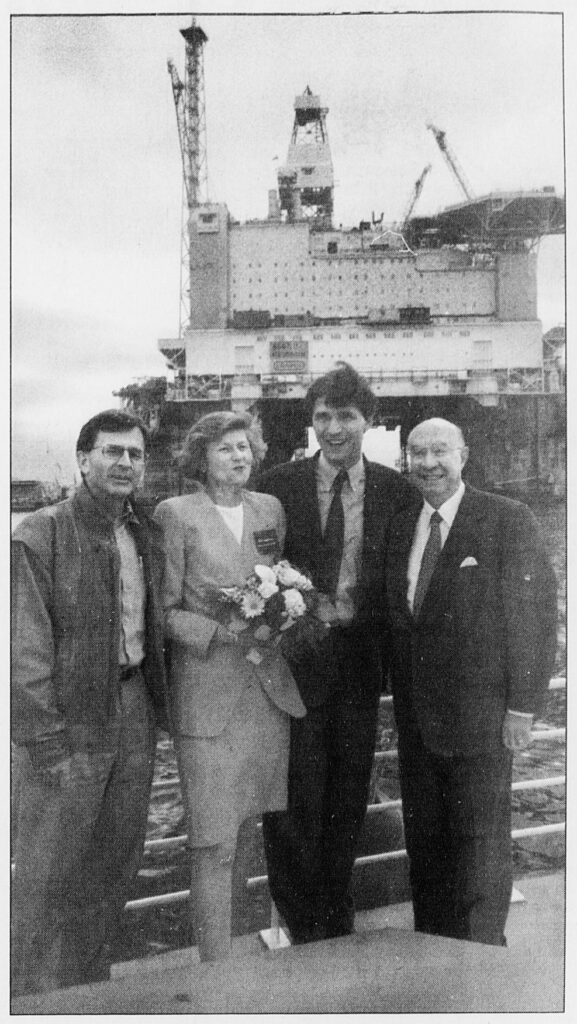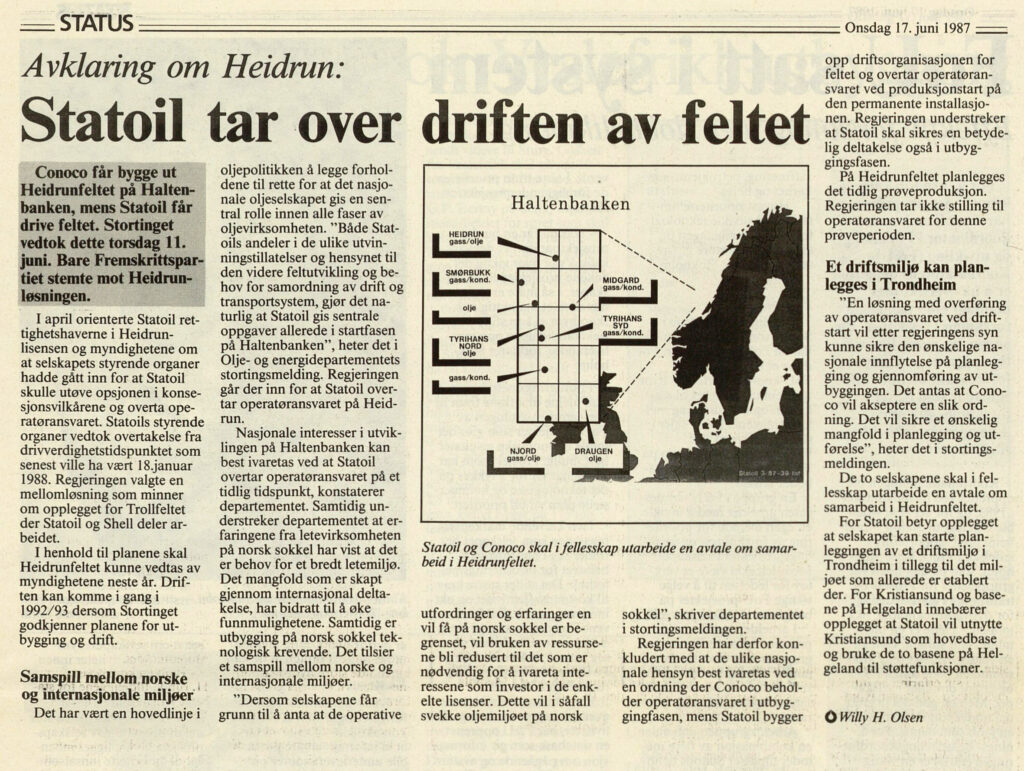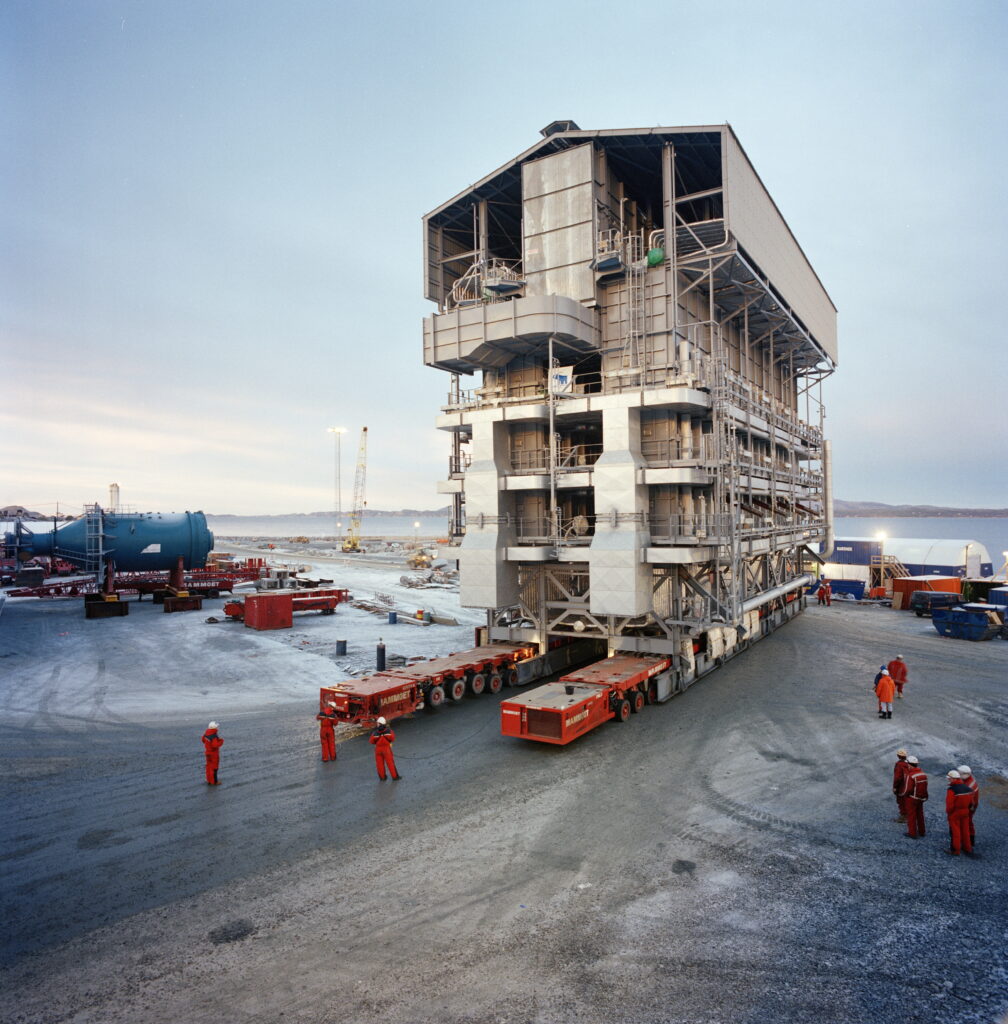Heidrun and the fight over the “mead”

The Norwegian Sea and the Barents Sea were opened for offshore exploration in 1980, and Statoil made several discoveries over the next few years – including Tyrihans, Smørbukk, Mikkel and Trestakk. Saga Petroleum and Norske Shell had also found Midgard and Draugen respectively. In 1985, Conoco’s Heidrun discovery ranked as the biggest oil find so far in this part of the Norwegian continental shelf (NCS).
Statoil was a partner in Heidrun, but as operator elsewhere had only found gas and condensate. Nor did these reserves appear commercial for the time being. In order to occupy the driving seat in developing the Norwegian Sea – and not least in the choice of transport solutions – it was important for the company to operate an oil field. The alternative was for the coordinator role to fall to rival Norsk Hydro, operator for the substantial Njord oil discovery nearby.
A commerciality report for Heidrun, submitted as early as the autumn of 1986, declared that the field could be developed and produced profitably. The Statoil board agreed in 1987 to support the declaration and produce a plan for development and operation (PDO). It was also resolved that the company would seek to exercise the option provided by the licence to take over the operatorship when a discovery was declared commercial.[REMOVE]Fotnote: Minutes, board meeting, Statoil, 26 February 1987, item 2/87 – 3, “Drivverdighetserklæring for Heidrun-feltet”.
A similar change of operatorship had already occurred on Statfjord, where Statoil took over from Mobil in 1987 after the field has been on stream for eight years. But that had not happened without controversy and a fight. Operator responsibility for Troll had also been split by the government, with Shell developing the gas part before Statoil took over production, and Hydro handling the oil development.
As operator, a company will exert a big influence on the choice of development solutions and also establish an organisation which means many jobs and big revenues.
Battle over remote control
Heidrun was Conoco’s first Norwegian operatorship, although it had already played a key role in NCS developments. The US company had been Statoil’s technical assistant on Gullfaks, but such a solution was not relevant on the Norwegian Sea discovery.

“We’ve done that for the Gullfaks project and won praise for it, but aren’t interested in doing it again,” said Conoco CEO Constantine Nicandros.[REMOVE]Fotnote: Stavanger Aftenblad, 25 April 1987.
Set to be the company’s biggest development on a global basis, Heidrun was due to yield more than 200 000 barrels per day at full production. So it was hardly surprising that Conoco expressed strong opposition to Statoil’s desire to take over. Nicandros reacted so quickly to these plans that he managed to secure a meeting with petroleum and energy minister Arne Øien even before the formal transfer request from Statoil had arrived.[REMOVE]Fotnote: Ibid, 25 April 1987.
“The question of allowing us to continue on Heidrun has something to do with the diversity of the Norwegian oil milieu,” the Conoco chief maintained. He added that such a decision would be perceived by the foreign companies as a strong signal about what their future role in Norway would be.[REMOVE]Fotnote: Ibid, 29 April 1987.
Where the Norwegian government was concerned, the main question it would have to resolve was whether the national interest was best served if Statoil served as sole coordinator for the Halten Bank area of the Norwegian Sea. The downside was the message communicated to the foreign companies in general that the good bits would be reserved for Norway and operator diversity limited.[REMOVE]Fotnote: Dagens Næringsliv, 15 April 1987.
The Norwegian Petroleum Directorate (NPD) opposed the Statoil request, precisely because it was desirable to retain a certain level of variety among operators active on the NCS.
While this conflict over the operatorship was under way, development and operation plans continued to be worked on in the licence.
Two partly-satisfied companies

The final outcome was a compromise. Conoco would be responsible for actually developing Heidrun, while Statoil would build up the production organisation and take over operation of the field when it came on stream. This result was described as the best the US company could hope for, given the political desire to prioritise national control and Statoil. The latter had wanted to develop the field as well, but had to settle for a compromise.
A tension-leg platform (TLP) with a floating concrete hull held to the seabed with steel tethers was chosen for Heidrun. Saga was pursuing a similar solution for its Snorre field at the same time, but with a steel hull. The Heidrun platform would combine drilling and production.[REMOVE]Fotnote: Minutes, board meeting, Statoil, 13 December 1989, item 11/89 – 3: “Plan for utbygging og drift av Heidrun-feltet”.
Seeking a gas solution
In work on the development plans, it became clear that the oil – the largest, most important and most profitable part of Heidrun’s resources – would be loaded into and shipped away by shuttle tankers. The associated gas produced together with the oil also had to be dealt with, even though it was not as profitable as the oil. It posed a problem with three possible solutions:
- injection back into the reservoir, which would cost money and postpone revenues from gas sales
- use as fuel for a gas-fired power station at Tjeldbergodden on the Norwegian coast, which would probably delay the start-up for the whole field
- provide feedstock for a methanol plant to be built at Tjeldbergodden.
In a consideration of the PDO in 1989, the Statoil board approved the operator’s proposed solution but with the reservation that “detail design will not begin until a final clarification exists about transport and disposal of the gas”.[REMOVE]Fotnote: Minutes, board meeting, Statoil, 13 February 1989, item 4/90-5 “Gassløsning for Heidrunfeltet”.

After the third option had been selected in 1990, Statoil began to establish the methanol plant together with Conoco and America’s DuPont.
The PDO was approved by the government in 1991, with the world’s first concrete-hulled TLP as the chosen solution. Oil would be loaded into shuttle tankers for shipment to the Mongstad terminal or other destinations, while the gas would be carried in the Haltenpipe pipeline to Tjeldbergodden.
Heidrun began producing oil in October 1995 and gas from 1997.
The methanol plant is the largest in Europe. Its opening marked the first large-scale industrial use of natural gas in Norway. Output from this facility represents about a quarter of Europe’s overall methanol production and roughly 10 per cent of its consumption. Equinor owns 82.01 per cent of the plant, with ConocoPhillips Scandinavia holding the remaining 17.99 per cent.[REMOVE]Fotnote: https://www.equinor.com/energy/onshore-facilities, accessed 9 February 2022.
arrow_backTroll A – giant move from fjord to fieldIrish gas with sour tastearrow_forward